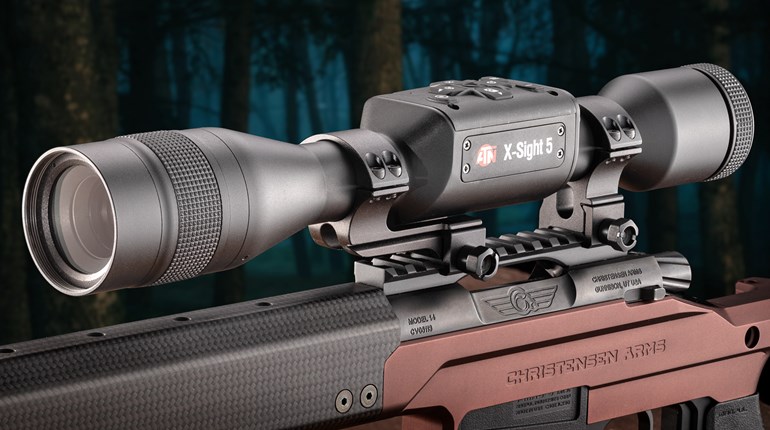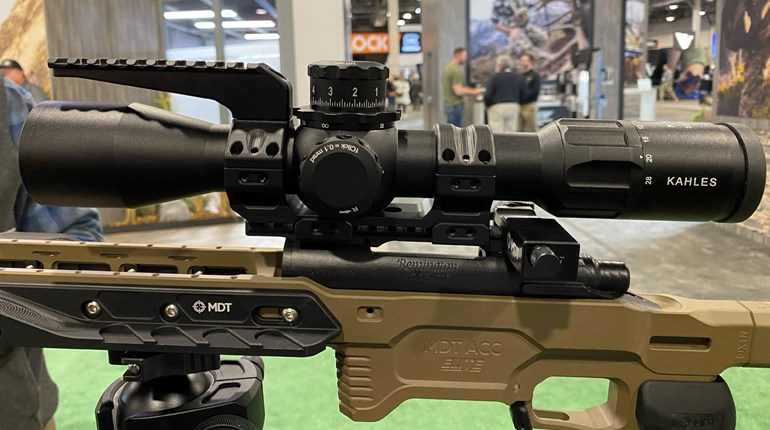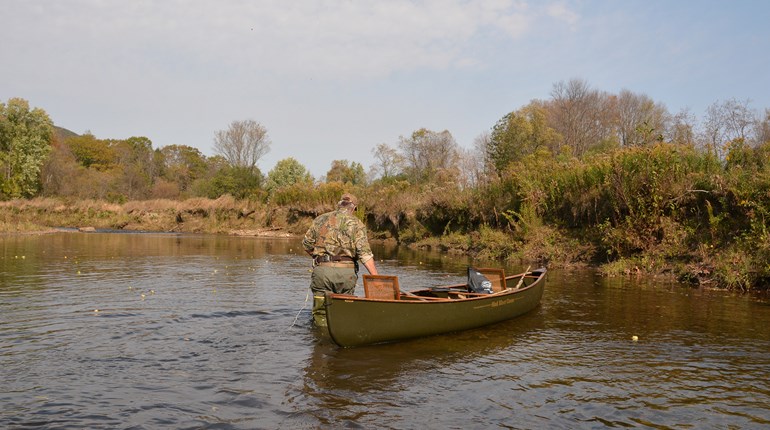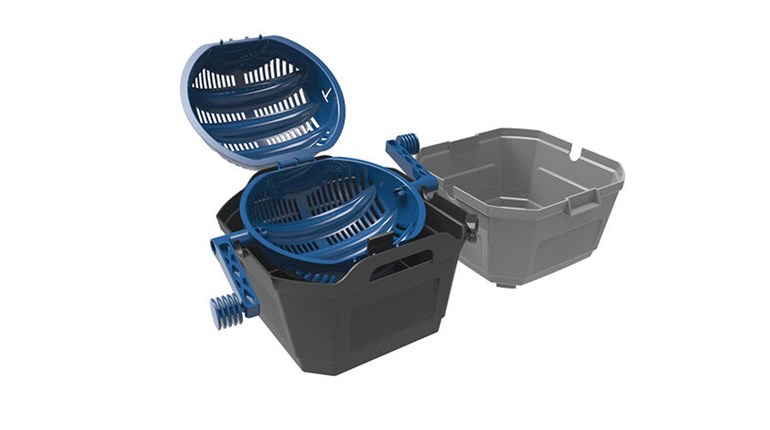- NRA Staff

Snipers are taught to avoid becoming targets by reducing the presence of indicators that help hostile forces detect them. The main things that will get you noticed in any environment are unnatural movements, sounds, smells and poor camouflage. A former Special Forces soldier reveals how his military training and the philosophies surrounding it can benefit hunters.
Gallery

What Camouflage to Use
The key to visually blending in with your surroundings is to break up your outline with colors and shapes that appear natural. Use a backdrop such as a large tree trunk, rock or dense thicket whenever sitting in one position. Snipers use ghillie suits to blend in effectively wherever possible, but these are not the ridiculously shaggy outfits commonly seen in movies. An effective ghillie makes great use of natural vegetation, a few shredded burlap strips and a camouflage base material. Unfortunately even simple ghillies are bulky and therefore not always practical to carry. Commercial camouflage has come a long way since the days of simple OD green. The best patterns use subtle, shadow-like effects and multiple natural color combinations. No one pattern works in all environments so having different blends to choose from helps. Striped patterns tend to work better in reeds and heavily wooded terrain, while blotched and speckled patterns are more suitable for leafy areas.
Don’t forget about your other equipment. Gun camo isn’t new but since many companies use a “one pattern fits all” approach, be prepared to break up the color scheme when you suddenly realize your mostly green smoke-pole doesn’t blend into the autumnal landscape. Improper camouflage can be worse than none whatsoever. Eliminate shiny surfaces and unnatural colors (except blaze orange where required, of course). If you do your own camo work, break up the gun’s long axis by painting or taping lines perpendicular to the barrel and stocks. Lastly, remember that an unconcealed face stands out in the wild. Making an extra effort to limit exposed skin just may give you the final edge that leads to a well-deserved payoff.

A Sniper's Story
I’m fortunate that most of my 21 years in Army uniform were spent working in reconnaissance postings, mostly as a SOF sniper. I was able to export lessons learned as a kid in the cornfields and hardwoods of northern Illinois to training areas and battlefields around the world, refining them along the way. Bringing those skills to bear in the high-stakes world of wartime sniping is a no-fail proposition but the skills that keep a “recce” soldier alive are also useful for hunting in more pleasant environments.
Snipers are taught to avoid becoming targets by reducing the presence of indicators that help hostile forces detect them. The main things that will get you noticed in any environment are unnatural movements, sounds, smells and poor camouflage. While good shooting skills and equipment are vital to hitting the intended point of aim, avoiding target indicators will help reduce the frequency of those “I’m busted” moments that seem to frequent the woods and fields of our hunts. Learning to mitigate the effects of these categories will help your pursuit of quarry whether you’re on the move or hunting in a static position.

Reduce Unnatural Movement
Our snipers fighting in the Middle East often encounter extreme long ranges. Magnified optics aid their efforts to pick up targets from distances far beyond the human eye’s unaided ability. An early experience in December 2001 found my team engaging targets out to approximately 4 kilometers with direct fire and close air support. Good spotting scopes, stabilized binoculars and lots of patience were vital to the mission; however, it was the physical movement of our targets that set them apart from their surroundings, which allowed us to find and engage them effectively over a period of several days. Our own movements were done slowly and methodically, using terrain to mask our presence while effectively keeping the heat off our own positions.
Most of the game we pursue when hunting has eyes that put our best field optics to shame. The ability to acutely see movement keeps many species alive through protection against predators and by identifying live food sources. Whether creeping through the woods on a still-hunt or approaching your stand, speed and sudden movements can betray you long before you’re even aware of game in the area.
Choosing routes through the woods that give you natural concealment is critical. Also, you need to move slowly and to avoid sky-lining yourself on hills and ridge tops. Walk just below the top along the “military crest” where you’re backed by higher ground. Dwell in the shadows when the sun is shining and move from one stand of vegetation to another, pausing periodically to look, listen and smell. Carefully pick your way through dense foliage and avoid breaking branches if you can’t find a way around it. Be sure to place terrain and vegetation between you and your prey when you are stalking in for a shot. If you get in close and decide you need to move laterally more than a few yards, you’ll present less of a signature by carefully backing out of sight, then moving to the side before coming back in to your target. This “cloverleaf” technique is part of Reconnaissance 101 and works very well.

Plan for the Wind
A few other techniques used by people who rely on stealth for their survival will work for hunters, too. Always remain cognizant of the wind direction and use it to your advantage by working downwind of your quarry whenever possible. My first coyote hunt was a real education in this arena. The swirling currents of New Mexico’s gullies and ridges forced us to move more frequently than normal and helped several wily dogs get away before we realized they were there. We finally hit pay dirt on the last stand of the hunt as the terrain and weather allowed us to hold the high ground while watching the best approaches, downwind of several hungry coyotes. This maxim is just as true for military personnel attempting to remain undetected in bad-guy land as it is for big-game and varmint hunters.
Even if we don’t smoke, chew or eat a greasy burger before the hunt, we can’t hide the body odor that accompanies exertion and time in the field. Unscented wet wipes, t alcum or cornstarch powders help keep body funk at bay without leaving traces of perfume. Apply non-perfumed insect repellents sparingly. Companies specializing in scent management offer unscented insect repellents and even the big brands offer plant-based repellents that are fairly effective at keeping human smells and bugs at bay.
Lastly, don’t forget that the things we carry can emanate their own unique—and very manmade—scents. Sun-warmed plastics, excessive gun oil, powder residue in a dirty barrel, treated leather and fabrics like oiled canvas are all very noticeable to sensitive noses. A good rule of thumb I use is that if I can smell something a foot or more away, animals can smell it well enough to avoid me.

Use Your Nose
Most hunters grasp the importance of scent management. The pitfalls presented by human and manmade smells are the same for military personnel but the repercussions for poorly concealing and managing them are drastically different.
The chance of being compromised by an enemy force and all the baggage that brings along with it compels stealth-minded troops to take this problem seriously. I learned just how easy it is to smell people from afar during my first multi-day patrol as a young private. After 48 hours away from soaps, deodorants and greasy mess-hall food, my sense of smell began to sharpen dramatically. I soon realized I could pick out a wide variety of manmade scents that I did not even know existed. A week of life in the wild will do wonders for your ability to pick up all smells—human, animal and natural. Once I got into the reconnaissance game I found that regardless of the environment—jungle, mountains, woodlands and, in some cases, even the desert—my teammates and I could detect the presence of other humans far enough out of sight to steer clear of trouble. Food smells alone helped our small teams avoid many chance encounters over the years.
Commercial solutions tend to focus specifically on body odors, which certainly need attention. I won’t go into their particulars here because, short of vacuum packing ourselves from head to toe, there is no way to completely eliminate this particular indicator. Instead I’ll cover some common-sense rules you can apply without re-clothing and re-equipping yourself.
Masking your scent at 4 a.m. on opening day helps to some degree but it won’t remove the traces of your spaghetti and garlic bread dinner from the prior evening. Your diet affects the way you smell hours (or days) after consumption. I spent a fair amount of time working in primitive overseas conditions where the local fare was either more pleasant or more plentiful than our issued MREs. One positive result of eating like the natives was that we also smelled more like them. While there’s no social benefit to this effect, it was tactically useful because people who eat and bathe differently don’t smell the same and that makes remaining undetected all the more challenging. I don’t think we need to strap on a feedbag of “Super Antler Grow” for breakfast, but avoiding strong-smelling foods before the hunt is good practice. Foods like cereal, granola, energy bars and less fragrant meals will reduce scents left on skin as well as those emanating from within.

Silence Everything
Perform a noise check before heading out the door or leaving your vehicle to begin a stalk. This simple procedure comes straight out of military-patrolling manuals and requires you to jump up and down while wearing all gear exactly as you plan to wear it in the woods, listening for any rattles, rubs, clanks or squeaks. What you hear may surprise you. Remedy the noisemakers before moving out. If you’re parked too close to your hunting grounds to chance any further racket, do your noise check the night prior with the exact same gear, including your firearm or bow. Remember to close automobile doors gently when near hunting areas.
Loud footfalls are tougher to combat but the same techniques used in harm’s way will work when hunting. It’s hard to tell where the dry branches and twigs are when walking in the dark or on a thick carpet of leaves, so I step very lightly, placing each foot down flatly, instead of rolling from heel to toe as in a normal step. This reduces the pressure placed on a normally small area (the heel) and spreads it over the entire print. It also allows me to feel small twigs under any portion of my foot before committing to the full weight of a step. Look for quiet lanes of movement. Exposed earth, large rocks, pine straw and moss are all quieter than dry leaves; however, after a good rain I’ll choose leaves over sand or gravel and avoid pine straw and rocks because they’re slippery when wet.
We all freeze in place when our equipment bangs together, but the damage has already been done by that point. I didn’t have treestands in the Army but I did have an externally framed rucksack, radio antennas and a bunch of other bulky equipment constantly begging to get me in trouble. The less gear you have on stand, the easier it will be to keep quiet. I used copious amounts of tape and padding to dampen metallic noises wherever possible in my hide sites.
Wrapping the rails of your treestand will muffle the tuning fork effect created when your rifle barrel tries to mate with it. Instead of leaning your long arm against something to free up your hands, sling it or lay it down (pointed in a safe direction).
I once had a soldier in my scout platoon who went into purple-faced coughing fits whenever we got within sight of an objective. He quickly went back to being a regular rifleman once we realized it was a nervous reflex due to stress. Keep throat lozenges handy to deal with any sudden need to cough that pops up at the wrong moment. Cough into your hat while crouching low to the ground to dampen the sound.

Stay Invisible on Stand
Sitting still for long periods can be a battle all by itself. Whether you’re trying to generate warmth, prevent your joints from seizing up or simply scanning for game, all movements must be slow and methodical. Before turning your head, move your eyes in the direction you want to turn until they reach the limit of your field of view. Next, slowly turn your head in that direction, continuing in this manner until you’ve scanned the area. Keep your rifle, shotgun or bow as close to a normal firing position as possible without fatiguing yourself while you wait. When the sudden pounding of your heart announces a potential shot, silently remind yourself to slow down. Move as slowly and naturally as possible when the time comes to shoot.



































